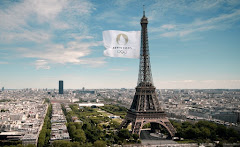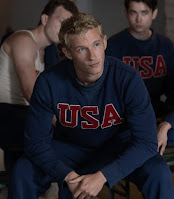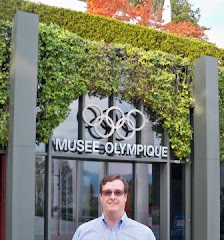Tuesday, March 12, 2024
Gracie Gold Gets Real with Page-Turning Autobiography "Outofshapeworthlessloser"
Saturday, February 3, 2024
They Just Felt Like Running; Notes from Orlando, Hosts to U.S. Olympic Team Trials for Marathon
This week in Orlando, U.S. Track & Field's entourage set up shop for the Paris 2024 edition, with elite runners taking to the streets of the city's Thornton Park, Lake Eola Heights and Milk Districts, a few blocks east of downtown.
With a three-lap, eight-mile loop course, the qualifying standards for Paris varied for women and men. In simple terms, the top three women with times of 2 hours, 29.5 minutes or faster (Nov. 1, 2022, to today) will represent Team USA this summer, while the men at 2:18 faster punch their ticket to the City of Lights. There were 165 female entrants to 215 men, ranging from age 22 to 47 for both genders. Also noteworthy were the four men and two women for whom the 2024 race marked their fifth consecutive marathon Olympic Trials.
I shudder to think about finishing a single marathon let alone five or more spanning 20 years/five Olympiads!As a member of the working media who touched down at MCO yesterday, from my perspective USATF and the Orlando organizers killed it on organizing.
The positive vibe with fellow reporters, hundreds of volunteers (including a couple of friends from Atlanta) and spectators was high energy, and the weather cooperated with mostly sunny skies yet moderate temps.
During the races, thousands of spectators lined the route including a mix of locals and out-of-towners. In a live interview with NBC Sports, Orlando's longtime Mayor Buddy Dyer stated his glee to add an Olympic trials and more guests atop the 70+ million annual visitors to the city.
At a Friday press conference, 2004 Olympic bronze medalist Deena Kastor and 1984 Olympic marathon champion Join Benoit Samuelson were on hand to commemorate the 40th anniversary of Benoit's gold in the first five-ringed marathon."Patience is going to be the name of the game," said Benoit Samuelson, referring to a runners' strategy for tackling the marathon course. She also offered that, in observing many of this year's entrants in the lobby of the host hotel, many runners are distracted now more than in the 1980s. "Everybody's online constantly, and I think that needs to change," she said.
By the marathons' conclusion, the Paris-bound runners included race favorites and Utah neighbors Conner Mantz of Provo and Clayton Young of Springville, as well as Leonard Korir of Colorado Springs, finishing in 2:09:05, 2:09:06 and 2:09:57, respectively.In her marathon and Olympic trials debut, Fiona O'Keeffe of Chapel Hill, N.C., finished first for the women in 2:22:10, with one of the race favorites -- 2020 Olympian in 10,000m Emily Sisson of Flagstaff, Ariz. -- at 2:22:42, then Hopkins, Minn., runner Dakotah Lindwurm in 2:25:31.
O'Keeffe also became the first first-time marathoner to win the Olympic trials at this distance, setting an Olympic trials record in the process. During the post-race press conference, she said her marathon naivite was a factor in the race.
"Not knowing what I was getting myself into was a good thing," O'Keeffe said. Part of the main pack for the first laps of the race, once she pulled ahead several reporters noted O'Keeffe "never looked back" as she gained an ever-increasing lead to the finish.
Via NBC's finish line camera work, when Mantz and Young came into view, they were visibly sharing words of encouragement for several hundred meters, following a mid-stride high five.
"I just wanted to take every step of the way with Conner over the last couple miles,” Young said. “Conner is the guy who has pulled me this entire build, day-in and day-out in practice. He works hard and he deserves this just as much as I do.” Young's daughters donned custom T-shirts proclaming "My Daddy Just Made the Olympic Team" (see photo below). Meanwhile, Korir dedicated his race to his U.S. Army commander and unit, who encouraged him since his fourth place finish in 2020. "For me to make the team ... this is for everybody who is serving in the Army," he said in a finish line interview with NBC Sports. Korir will have to patiently await official word of his Paris travel status, with an additional qualifying stage The Athletic explains in the penultimate paragraph of this article. This blogger sure hopes he makes it, and that "The Three Musketeers" of both Team USA's marathon women and men find a way "one for all and all for one" when they race on Aug. 10 and 11 in the Olympic city.Image credit: Nicholas Wolaver in Orlando. Race footage on big screens via USATF and NBC Sports.
Wednesday, January 10, 2024
Shallow Writing Sinks "The Boys In The Boat"
With thanks to Allied Global Marketing for the pre-Christmas media ticket, my response to their rep was that I really wanted to love this movie -- based on a great book by Daniel James Brown -- but didn't as there were too many issues, starting with writing as shallow as the eight-man sculls on screen.
In the weeks since the Dec. 18 screening in Atlanta, an online search yielded that at least one film critic deemed the George Clooney 2023 picture comparable to the 1981 Oscar-winning best picture directed by Hugh Hudson with a screenplay by Colin Welland (who also earned an Academy Award, among four wins from seven nominations for the outstanding earlier film).
"'The Boys In The Boat' is like 'Chariots of Fire' on the water," wrote James Verniere of the Boston Herald.
With all due respect to Mr. Verniere, it's not.
Not even close.
Looking for the good, the costume team led by veteran designer Jenny Eagan nailed it.It's impressive on the big screen that "The Boys in the Boat" Olympic attire -- from Team USA's uniforms to the athlete and official Berlin Olympic pins -- all pops with authenticity, right down to the colored ribbons that served as the era's Olympian accreditation.
In a publicity video, Eagan describes some of her team's creative process:
While drafting this post, I sent a LinkedIn message to Eagan requesting an interview as her press clip above did not answer my key questions on her team's research of the Berlin uniforms, pins and other 1936 attire (when she responds, a follow up post or update in this one may follow).
Paraphrasing the night-of-screening remarks by my guest for the viewing event, the film's production design team also deserves a shout-out for what seemed to be a mostly accurate depiction of the 1936 Games on the waters of Berlin's Langer See, the river-filled lake which served as the rowing venue. From the credits, it's my understanding a Canadian reservoir was the crew's home and set for many takes.
But back to the issues that sunk the film for this blogger.
As noted, strike one was the writing as I found Mark L. Smith's screenplay flat, predictable and, more than once, annoying for its missed opportunities.
Too many times I felt like turning to my seatmates and stating, "and now [insert character name] is going to state [fill in the blank with aptly anticipated often monosyllabic retort]." Did the head coach reject his wife's late-night flirtations because he was tired or because they were written so silly? Tough call. But worse, who cared? As evidenced with a mid-film popcorn and pee break, I stopped paying attention an hour earlier!In another example, viewers meet the wise old longboat craftsman who spouts wisdom and the lore of rowing from a lifetime of experience, but the writing is so dumbed down, my thoughts drifted to fresh lyrics for the popular nursery rhyme, "Row, row, row your boat, gently on the screen, wearily, wearily, wearily, wearily, weaker than a meme!"
The second strike was shallow character development. While Brown sank the oars deep into history and his Olympian (and coaching) characters on the pages of his book, Smith's screenplay only skimmed the surface floating too many stories with no depth while failing to tie up numerous loose ends by the final scenes.The audience meets, for instance, the main protagonist and his love interest, who clearly supports his athletic interests across two continents and an ocean. But by the time the closing credits roll, the audience exits wondering what happened to her once a flashback device lifted directly from "Saving Private Ryan" returns viewers from Berlin '36 to modern times. Did the main character marry her? Who knows? Who cares? Not Smith, and the screenplay instead called for rolling the credits.
Squandering Joel Edgerton's talent -- on the heels of his memorable lead role in "Master Gardener" -- also left me scratching and shaking my head. The scenes of the coach he portrayed, and his wife, were just weird, or too PG, and their relationship status proved another unresolved cliffhanger by the film's conclusion. Worse still, he's never given the words nor actions to equal coach Sam Mussabini as portrayed by Sir Ian Holm.Strike three: Non sequitur micro-dramas also abound, such as the awkward introduction of a dining car social class showdown aboard the New England-bound train to the Olympic trials, or a square-pegged moment with Jesse Owens that omits mention of Team USA's other Black athletes in Berlin. Then, after this nod to history, the screenplay has the audacity to suggest the Führer himself became more exasperated by Team USA rowers than Owens' track and field feats. Nein.
Auch Nein for portraying the international rowing judge in Nazi attire. But thanks to Eagan's team, at least the uniform looked right.
Mega NEIN the protagonist's love interest could find a radio broadcast of Olympic rowing ... live ... from Berlin ... with a nine-hour time difference that assumes the race on a lake half-way across the globe had an afternoon start time. Even if you were in love, as a 1936 Seattle resident, would you be awake before dawn rapturously tuned-in to rowing commentary live from Germany? Would you be tuned in from the East Coast, or anywhere?
The most nervig, er, annoying scene of all arrived when a key character finds himself kicked off the team only to have his Olympian status restored thanks to poor man's version of Richard Gere's "I got nowhere else to go!" speech to Louis Gossett Jr. in "An Officer and a Gentleman." Sadly, the rowing version is not at all quotable.
Also missing from "The Boys in the Boat" is a memorable soundtrack. For all of Alexandre Desplat's strengths and skills as a composer, it was disappointing that even the film's score seemed to be trying too hard. The only time it worked was in support of the final race. No Vangelis here.
For a comparison, you can hear the Greek composer's Oscar-winning score just by its mention here, yes? No one's gonna by humming nor jogging, nor rowing, to "The Boys in the Boat" soundtrack.
I'm not pulling solo, single skull-style with some of my perspectives, according to the AP's review by Jocelyn Noveck. Though she's a bit kinder and more professional in her remarks, her notes on the screenplay are apt. Silver Screen Capture's writer also catches my drift.
To his credit, Clooney mentioned one point of the film was to bring people together to cheer a common cause. He must be onto something because, curiously, there were a lot of cheers when Team USA won gold in the Dec. 18 screening auditorium. A crowd pleaser? Perhaps. (Our screening was packed with high school and college rowers.)Someday when I'm afforded an opportunity to speak with Herr Director George, just like Sister Nancy Usselman (see photo), my first question will be the extent to which the final Olympic race and its clunky camera angles took inspiration from SCTV 3-D Theatre. In the early 1980s, was Clooney tuned in to John Candy, too (at the :45 and 1:20 marks in this clip)?
The bottom line is that too often it felt "The Boys in the Boat" tried too hard (und scheiterte) to accomplish too much, and audiences can do themselves a favor by instead watching "Chariots of Fire" for inspiration.
Image credits: Penguin Random House book cover, Calum Turner image via the X account @CTurnerUpdates on which no photo credit was shared, stills by Laurie Sparham/MGM, Clooney red carpet premiere photo via the Pauline Center for Media Studies blog on which no photo credit was given to Sister Usselman's camera operator.
Who Is Writing?
- Nicholas Wolaver
- Atlanta, Ga., United States
- A public relations executive by day, small-time eBayer by night and weekends, lifetime member of the International Society of Olympic Historians (ISOH) and full-time Olympic enthusiast who also looks at "BoingBoing-style" unusual news with interest. Please e-mail me at olympiada@yahoo.com or if you can't get enough try my Facebook page http://www.facebook.com/people/Nicholas_Wolaver/713593008
Paris en 2024

Future Olympic Hosts
Olympics On Film

Olympic Film Reviews
Films With Five-Ringed Connections
- 21 Hours At Munich
- AIR - Courting a Legend
- American Sniper
- Boys in the Boat, The
- Bronze (The Bronze)
- Chariots of Fire
- Charlie Chan At The Olympics
- Cool Runnings
- Cutting Edge (The Cutting Edge)
- Documentaries of Bud Greenspan
- Downhill Racer
- Eddie The Eagle
- Face Of Ukraine: Casting Oksana Baiul
- Foxcatcher
- Greatest (The Greatest)
- I, TONYA
- Icarus
- Ice Castles
- International Velvet
- Jim Thorpe: All-American
- Miracle
- Molly's Game
- Munich
- Munich 72 And Beyond
- Olympia
- Olympic Dreams
- Olympic Pride, American Prejudice
- One Day In September
- Personal Best
- Prefontaine
- Race
- Richard Jewell
- Roads To Olympia
- Tokyo Olympiad
- Twenty Twelve (BBC)
- Unbroken
- Whitney
- Without Limits
Other Five-Ringed Blogs
-
Olympic chief Bach backs world doping body over positive Chinese tests - The head of the International Olympic Committee Thomas Bach has backed the World Anti-Doping Agency in a row over its handling of positive drug tests by 23...3 hours ago
-































